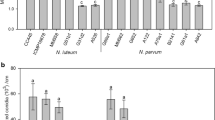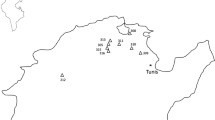Abstract
Black foot disease, caused by Ilyonectria liriodendri and Dactylonectria macrodidyma, is a significant disease of grapevines both in New Zealand and worldwide. The aim of this study was to determine the pathogenicity of New Zealand I. liriodendri and D. macrodidyma isolates in two grapevine rootstocks as callused and rooted propagation material. Three isolates each of I. liriodendri and D. macrodidyma, all infected callused and root-wounded grapevine rootstock plants (varieties ‘101–14’ and ‘5C’). Isolates from each species caused high disease incidences and severities at both 1 and 5 cm above the stem base. There were no significant differences in disease incidence or severity between rootstocks ‘101–14’ and ‘5C’. However, vines arising from callused rootstock had significantly higher disease incidence and severity compared with rooted vines. Conidia caused greater disease incidence and severity compared with chlamydospores and mycelium. A novel threshold propagule experiment with I. liriodendri propagules determined that disease incidence and severity at the stem base were significantly affected by the concentration of the propagules rather than the propagule type. Root dry weights significantly differed between I. liriodendri and D. macrodidyma isolates but not between species. Root dry weights were higher with callused versus rooted vines, with mycelium versus chlamydospores or conidia, and with propagule concentration rather than propagule type. Shoot dry weights were significantly higher for I. liriodendri compared with D. macrodidyma species, rooted versus callused vines and ‘101–14’ compared with ‘5C’ rootstocks. The results of the study has confirmed that both I. liriodendri and D. macrodidyma were capable of infecting grapevines through wounded roots or callused basal ends, indicating that these pathogens are capable of invading grapevines either in nurseries or in vineyards.






Similar content being viewed by others
References
Agusti-Brisach, G., & Armengol, J. (2013). Black-foot disease of grapevine: An update on taxonomy, epidemiology and management strategies. Phytopathologia Mediterranea, 52, 245–261.
Alaniz, S., Leon, M., Vincent, A., Garcia-Jimenez, J., Abad-Campos, P., & Armengol, J. (2007). Characterization of Cylindrocarpon species associated with black foot disease of grapevine in Spain. Plant Disease, 91, 1187–1193.
Alaniz, S., Armengol, J., Leon, M., Garcia-Gimenez, J., & Abad-Compos, P. (2009). Analysis of genetic and virulence diversity of Cylindrocarpon liriodendri and C. macrodidymum associated with black foot disease of grapevine. Mycological Research, 113, 16–23.
Beute, M. K. (1971). Factors affecting Stromatina root rot of gladiolus. Phytopathology, 61, 1329–1331.
Bleach, C. M. (2013). Management of Cylindrocarpon black foot disease in New Zealand nurseries and vineyards. In PhD thesis. New Zealand: Lincoln University.
Bonfiglioli, R. (2005). New Zealand update on black foot disease. Australian and New Zealand Grapegrower and Winemaker, 499, 23–26.
Brayford, D. (1992). In L. L. Singleton, J. D. Mihail, & C. M. Rush (Eds.), Cylindrocarpon in Methods for Research on Soilborne Phytopathogenic Fungi (pp. 103–106). St Paul: American Phytopathology Society.
Cabral, A., Groenewald, J. Z., Rego, C., Oliveria, H., & Crous, P. W. (2012a). Cylindrocarpon root rot: Multi-gene analysis reveals novel species within the Ilyonectria radicicola species complex. Mycological Progress, 11, 655–688.
Cabral, A., Rego, C., Nascimento, T., Oliveria, H., Groenewald, J. Z., & Crous, P. W. (2012b). Multi-gene analysis and morphology revel a novel Ilyonectria species associated with black foot disease of grapevines (Vitis spp.). Fungal Biology, 116, 62–80.
Cabral, A., Rego, C., Crous, P. W., & Oliveria, H. (2012c). Virulence and cross-infection potential of Ilyonectria spp. to grapevine. Phytopathologia Mediterranea, 51, 340–354.
Carlucci, A., Lops, F., Mosert, L., Francois Halleen, F., & Raimondo, M. L. (2017). Occurrence fungi causing black foot on young grapevines and nursery rootstock plants in Italy. Phytopathologia Mediterranea, 56, 10–39.
Douglas, D. R. (1970). The effect of inoculum concentration on the apparent resistance of muskmelons to Fusarium oxysporum f. sp. melonis. Canadian Journal of Botany, 48, 687–693.
Garrido, L. R., Sonego, O. R., & Urben, A. F. (2004). Cylindrocarpon destructans causal agent of grapevine black-foot in Rio Grande do Sul. Fitopatologia Brasileira, 29, 548–550.
Gramaje, D., Alaniz, S., Abad-Campos, P., Garcı́a-Jiménez, J., & Armengol, J. (2016). Evaluation of grapevine rootstocks against soilborne pathogens associated with trunk diseases. Acta Horticulturae, 1136, 245–249.
Grasso, S., & Magnano Di San Lio, G. (1975). Infections of Cylindrocarpon obtusisporium on grapevines in Sicily. Vitis, 14, 36–39.
Halleen, F., Crous, P. W., & Petrini, O. (2003). Fungi associated with healthy grapevine cuttings in nurseries, with special reference to pathogens involved in the decline of young vines. Australasian Plant Pathology, 32, 47–52.
Halleen, F., Schroers, H. J., Groenewold, J. Z., & Crous, P. W. (2004). Novel species of Cylindroncarpon (Neonectria) and Campylocarpon gen. Nov. associated with black foot disease of grapevines (Vitis spp.). Studies in Mycology, 50, 431–455.
Halleen, F., Fourie, P. H., & Crous, P. W. (2006). A review of black foot disease of grapevine. Phytopathologia Mediterranea, 45, 55–67.
Heltoft, P., Brierley, J. L., Lees, A. K., Sullivan, L., Lynott, J., & Hermansen, A. (2016). The relationship between soil inoculum and the development of fusarium dry rot in potato cultivars Asterix and Saturna. European Journal of Plant Pathology, 146, 711–714.
Horsfall, J. G., & Dimond, A. E. (1960). Plant pathology: An advanced treatise (Vol. 3). New York: Academic Press.
Lebeda, A., Luhova, L., & Sedlarova, M. (2001). The role of enzymes in plant-fungal pathogens interactions. Journal of Plant Diseases and Protection/Zeitschrift fur Pflanzenkrankheiten und Pflanzenschutz, 108, 89–111.
Lombard, L., Van Der Merwe, N. A., Groenewald, J. Z., & Crous, P. W. (2014). Lineages in Nectriaceae: Re-evaluating the genetic status of Ilyonectria and allied genera. Phytopathologia Mediterranea, 53, 515–532.
Lyr, H., & Kluge, E. (1968). Relationship between pathogenicity, enzyme and toxin production in Nectria radicicola. Phytopathologische Zeitschrift, 62, 220–231.
Maluta, D. R., & Larignon, P. (1991). Pied-noir: Mieux vant prevenir. Viticulture, 11, 71–72.
Manici, L. M., Kelderer, M., Caputo, F., Saccà, M. L., Nicoletti, F., Topp, A. R., & Mazzola, M. (2018). Involvement of Dactylonectria and Ilyonectria spp. in tree decline affecting multi-generation apple orchards. Plant and Soil, 425, 217–230.
Matturi, S. T., & Stenton, H. (1964). The behaviour in soil of spores of four species of Cylindrocarpon. Transactions of the British Mycological Society, 47, 589–599.
Oliveira, H., Rego, C., & Nascimento, T. (2004). Decline of young grapevines caused by fungi. Acta Horticulturae, 652, 295–304.
Outram, M. A., Jones, E. E., Jaspers, M. V., & Ridgway, H. J. (2014). Development of a PCR-RFLP method to distinguish species within the Ilyonectria macrodidyma complex. New Zealand Plant Protection, 67, 151–156.
Pan, R.-H., Wang, J.-C., Wang, L., Ling, N., Zhang, H., Shen, Q.-R., & Huang, Q.-W. (2014). Isolation and identification of ginger Fusarium wilt pathogen and the effect of spore suspension concentration on the extent of disease. Journal of Nanjing Agricultural University, 37, 94–100.
Pathrose, B. (2012). Characterising sub-species variation in New Zealand Cylindrocarpon species that cause black foot of grapevines. In Unpublished PhD thesis. New Zealand: Lincoln University.
Pathrose, B., Jones, E. E., Jaspers, M. V., & Ridgway, H. J. (2014). High genotypic and virulence diversity in Ilyonectria liriodendri isolates associated with black foot disease in New Zealand vineyards. Plant Pathology, 63, 613–624.
Petit, E., & Gubler, W. D. (2005). Characterization of Cylindrocarpon species, the cause of black foot disease of grapevine in California. Plant Disease, 89, 1051–1059.
Probst, C., Jones, E. E., Ridgway, H. J., & Jaspers, M. V. (2012). Cylindrocarpon black foot in nurseries—Two factors that can increase infection. Australasian Plant Pathology, 41, 157–161.
Rahman, M., & Punja, Z. K. (2005). Factors influencing development of root rot on ginseng caused by Cylindrocarpon destructans. Phytopathology, 95, 1381–1390.
Rego, C., Oliveira, H., Carvalho, A., & Phillips, A. (2000). Involvement of Phaeoacremonium spp. and Cylindrocarpon destructans isolates from grapevines in Portugal. Phytopathologia Mediterranea, 39, 76–79.
Rego, C., Nascimento, T., & Oliveira, H. (2001). Characterisation of Cylindrocarpon destructans isolates from grapevine in Portugal. Phytopathologia Mediterranea, 40, S343–S350.
Scheck, H., Vasquez, S., Fogle, D., & Gubler, W. D. (1998). Grape growers report losses to black-foot and grapevine decline. California Agriculture, 52, 19–23.
Shaw, D. V., Gubler, W. D., & Hansen, J. (1997). Field resistance of Californian strawberries to Verticillium dahliae at three conidial inoculum concentrations. HortScience, 32, 711–713.
Sippell, D. W., & Hall, R. (1982). Effects of pathogen species, inoculum concentration, temperature and soil moisture on bean root rot and plant growth. Canadian Journal of Plant Pathology, 4, 1–7.
Taylor, G. S. (1964). Fusarium oxysporum and Cylindrocarpon radicicola in relation to their association with plant roots. Transactions of the British Mycological Society, 47, 381–391.
Tewoldemedhin, Y. T., Mazzola, M., Mostert, L., & McLeod, A. (2011). Cylindrocarpon species associated with apple tree roots in South Africa and their quantification using real-time PCR. European Journal of Plant Pathology, 129, 637–651.
Úrbez-Torres, J. R., Haag, P., Bowen, P., & O’Gorman, D. T. (2014). Grapevine trunk disease in British Columbia: Incidence and characterisation of the fungal pathogens associated with black foot disease of grapevines. Plant Disease, 98, 456–468.
Walker, M. A., & Boursiquot, J. M. (1992). Ampelographic and isozyme data correcting the misnaming of the grape rootstock SO4 at the University of California, Davis. American Journal of Enology and Viticulture, 43, 261–265.
Whitelaw-Weckert, M. A. (2007). Root infection of Vitis vinifera by Cylindrocarpon liriodendri. Australasian Plant Pathology, 36, 403–406.
Whitelaw-Weckert, M. A., Rahman, L., Appleby, L. M., Hall, A., Clark, A. C., Waite, H., & Hardie, W. J. (2013). Co-infection by Botryosphaeriaceae and Ilyonectria spp. fungi during propagation causes decline of young grafted grapevines. Plant Pathology, 62, 1226–1237.
Yoo, J. S., Cho, J. W., Jo, J. S., & Yu, S. H. (1996). Effect of physical and chemical factors in the formation and germination of chlamydospores of Cylindrocarpon destructans causing root rot of Panax ginseng. Korean Journal of Plant Pathology, 12, 422–427.
Acknowledgments
The authors acknowledge New Zealand Winegrowers and Lincoln University for funding and Technology for Industry Funding (Callaghan Innovation), New Zealand Ministry of Science and Innovation for providing a scholarship to the first author. The authors are also grateful to Cloudy Bay Vineyard, Marlborough for providing space for a pot experiment and technical advice, and the Lincoln University nursery staff for assistance with setting up and maintenance of the experiments.
Funding
Funding was provided by New Zealand Winegrowers, Technology for Industry Funding (Callaghan Innovation) New Zealand Ministry of Science and Innovation (Postgraduate research scholarship awarded to the first author) and Lincoln University.
Author information
Authors and Affiliations
Corresponding author
Ethics declarations
Conflict of interest
None of the authors declare a conflict of interest, with all authors consenting to publication.
Rights and permissions
About this article
Cite this article
Probst, C.M., Ridgway, H.J., Jaspers, M.V. et al. Pathogenicity of Ilyonectria liriodendri and Dactylonectria macrodidyma propagules in grapevines. Eur J Plant Pathol 154, 405–421 (2019). https://doi.org/10.1007/s10658-018-01664-0
Accepted:
Published:
Issue Date:
DOI: https://doi.org/10.1007/s10658-018-01664-0




